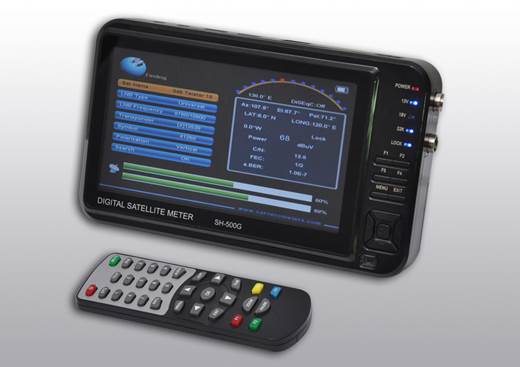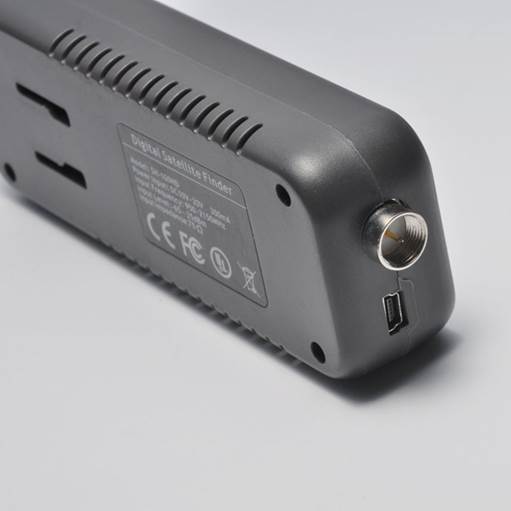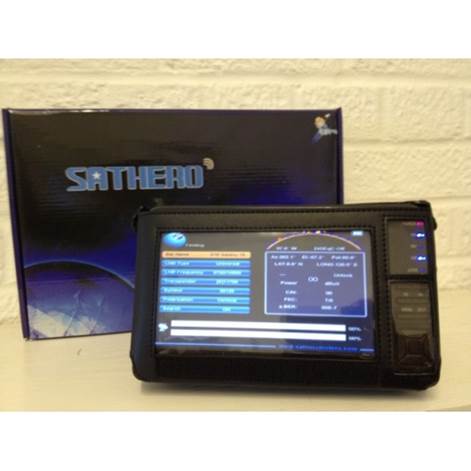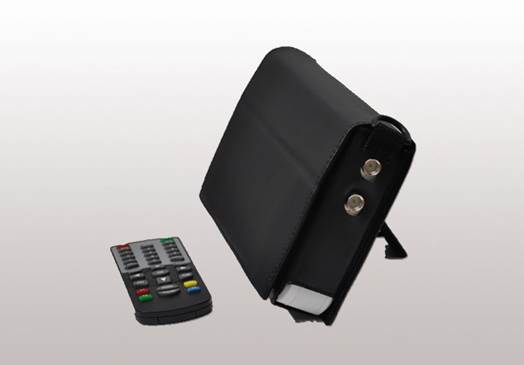This ‘sat meter’ is more of a
portable satellite receiver with some useful ‘installer’ features
Sathero’s SH-500G doesn’t feel quite as
robust as we’d like, and the 7in 16:9 display screen is built into a rather
flimsy plastic enclosure. An outer ‘jacket’ and neck strap are provided,
offering some protection to the device, but care should still be taken not to
drop the unit.
Next to the screen is a menu joypad, a set
of function-dependent smart-keys and a series of LEDs that confirm signal lock,
LNB voltage, 22kHz tone status and charging of the internal 2.6Ah lithium-ion
battery pack.

Sathero
SH-500G
On the side of the unit are a pair of ‘F’
connectors. One is connected to the LNB of the dish to be aligned, while the
other provides a simple cable-test function. Connect one end of the cable to
this, and the other to the LNB input. If all is well, a ‘cable OK’ message is
displayed on-screen. Sadly, this second F connector does not support LNB loop though.
On top of the receiver are 3.5mm
composite-video AV inputs and outputs. You can feed the meter’s screen from an
external AV source, or use it as a receiver with an external TV. Reflecting
this dual role, a remote handset is also provided; it’s an arguably of limited
value for dish-alignment work! Operated without the jacket, a flip-out stand
props up the unit for TV use.
Functions are arranged into installation
(choosing and scanning satellites), system-setting (AV matters, date/timer,
languages, measurement units and so on), channel-editing (deleting/moving
channels and assigning favorites), satellite-specific angle calculation, motor
configuration (DiSEqC 1.0/1.1/1.2/USALS are catered for) and finding
(measurement) menus.
The look and feel of the menus is very
similar to those of a budget FTA receiver. If you have experience of these,
you’ll quickly get to grips with the SH-500G. This intuitive feel is perhaps just
as well, considering the sparse nature of the accompanying instructions.
Pressing the buttons through the clear plastic of the carrying case can,
however, be awkward and is easier without.

On
top of the receiver are 3.5mm composite-video AV inputs and outputs
Twin receivers
The SH-500G is, in fact, two satellite
receivers in one. The first one fulfils the conventional role of receiving
DVB-S transmissions (note that DVB-S2 signals can be measured, but not
‘decoded’). You can scan individual transponders or full satellites, and
there’s a blind scan mode in addition to the usual auto, manual and network
scans of all or FTA-only channels.
Also buried deep in the SH-500G’s innards,
though, is a GPS receiver. This allows the ‘angle’ menu to calculate the elevation,
azimuth and LNB skew angles for a given broadcast satellite at your specific
location.
On the other hand, the Promax unit features
a superb spectrum analyzer. There’s no such function here; metering or
‘finding’ functions are restricted to the usual ‘power’ (signal level, in dB V or dBm), carrier to noise ratio and bit-error rate of the
currently-selected transponder.
V or dBm), carrier to noise ratio and bit-error rate of the
currently-selected transponder.
An internal speaker, needed for
conventional FTA-only ‘receiver’ operation, also provides audible confirmation
of signal level (something the Promax doesn’t offer). The frequency of its
‘bipping’ increases with signal level, enabling you to peak the dish without
having to stare at the screen.

SH-500G
suffers from the same design inadequacy that we met on the SH-200 a couple of
issues back
Unfortunately, the SH-500G suffers from the
same design inadequacy that we met on the SH-200 a couple of issues back. Its
charger connects via a USB-type terminal, but delivers 14.5 volts of DC as
opposed to the 5 volts enshrined in the USB standard.
This means you cannot use a computer’s USB
port to recharge the unit and, were you to accidentally plug the SH-500G
charger into a ‘true’ USB port, damage is almost inevitable. The USB port also
allows the firmware and spreadsheet-format channel databases to be updated via
a comparatively-slow serial interface, but the necessary cable is provided.
Verdict
This aside, the SH-500G acquitted itself
well. It’s responsive in use, and changes to settings can be made ‘on the fly’.
The channel-finding functions were speedy, while the blind-scan and
‘stand-alone’ receiver functions will certainly appeal to enthusiasts. We
obtained just under three hours of continuous operation, which correlates to
the manufacturer’s spec.

The
channel-finding functions were speedy, while the blind-scan and ‘stand-alone’
receiver functions will certainly appeal to enthusiasts
Features
§ RF
connections: Chassis F-plugs for input and ‘test’
§ Other
connections: Non-standard USB (firmware updates, charger)
§ Freq
range: 950-2150MHz
§ LNB
compatibility: User definable local-oscillator frequency, 22kHz switching,
13/18V polarity
§ Signal
metering: Level (audible confirmation, level in dB V or dBM) C/N ratio, BER V or dBM) C/N ratio, BER
§ Dish
alignment: GPS-powered angle calculator, DiSEqC 1.0/1.1/1.2/USUALS
§ Symbol
rate: 2Msps – 45Msps
§ Accuracy:
Not specified
§ Battery
life: 3 hours from user-replaceable 2550mAh lithium-ion pack
§ Memory:
16MB (at least 100 satellites and 3000 channels!)
§ Weight:
0.6kg
§ Dimensions:
210x125x35mm
Ratings
Plus
§ Very
easy to use
§ Channel
monitoring works well
§ Metering
of practical value
§ Good
value for money
Minus
§ Non-standard
‘USB’
§ Not
robust enough for serious professional use
§ No
LNB loop through
§ Cannot
view DVB-S2 channels
§ Build:
7/10
§ Setup:
8/10
§ Searching:
8/10
§ Navigation:
8/10
§ Performance:
8/10
§ Features:
9/10
§ Value:
8/10
§ Overall:
8.2/10
|